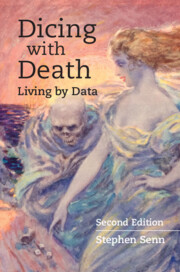Refine search
Actions for selected content:
2703 results in General statistics and probability
Notes
-
- Book:
- Dicing with Death
- Published online:
- 18 November 2022
- Print publication:
- 08 December 2022, pp 297-316
-
- Chapter
- Export citation
Permissions
-
- Book:
- Dicing with Death
- Published online:
- 18 November 2022
- Print publication:
- 08 December 2022, pp xvi-xvi
-
- Chapter
- Export citation
12 - Going Viral
-
- Book:
- Dicing with Death
- Published online:
- 18 November 2022
- Print publication:
- 08 December 2022, pp 255-296
-
- Chapter
- Export citation
3 - Trials of Life
-
- Book:
- Dicing with Death
- Published online:
- 18 November 2022
- Print publication:
- 08 December 2022, pp 54-73
-
- Chapter
- Export citation
8 - A Dip in the Pool
-
- Book:
- Dicing with Death
- Published online:
- 18 November 2022
- Print publication:
- 08 December 2022, pp 157-177
-
- Chapter
- Export citation
Copyright page
-
- Book:
- Dicing with Death
- Published online:
- 18 November 2022
- Print publication:
- 08 December 2022, pp iv-iv
-
- Chapter
- Export citation
11 - The Empire of the Sum
-
- Book:
- Dicing with Death
- Published online:
- 18 November 2022
- Print publication:
- 08 December 2022, pp 234-254
-
- Chapter
- Export citation
9 - The Things that Bug Us*
-
- Book:
- Dicing with Death
- Published online:
- 18 November 2022
- Print publication:
- 08 December 2022, pp 178-205
-
- Chapter
- Export citation

Exponential Families in Theory and Practice
-
- Published online:
- 25 November 2022
- Print publication:
- 15 December 2022

Dicing with Death
- Living by Data
-
- Published online:
- 18 November 2022
- Print publication:
- 08 December 2022
Part I - Elements of Probability Theory
-
- Book:
- Principles of Statistical Analysis
- Published online:
- 22 July 2022
- Print publication:
- 25 August 2022, pp 1-2
-
- Chapter
- Export citation
21 - Regression Analysis
- from Part III - Elements of Statistical Inference
-
- Book:
- Principles of Statistical Analysis
- Published online:
- 22 July 2022
- Print publication:
- 25 August 2022, pp 329-355
-
- Chapter
- Export citation
3 - Distributions on the Real Line
- from Part I - Elements of Probability Theory
-
- Book:
- Principles of Statistical Analysis
- Published online:
- 22 July 2022
- Print publication:
- 25 August 2022, pp 34-40
-
- Chapter
- Export citation
Dedication
-
- Book:
- Principles of Statistical Analysis
- Published online:
- 22 July 2022
- Print publication:
- 25 August 2022, pp vii-vii
-
- Chapter
- Export citation
6 - Multivariate Distributions
- from Part I - Elements of Probability Theory
-
- Book:
- Principles of Statistical Analysis
- Published online:
- 22 July 2022
- Print publication:
- 25 August 2022, pp 68-77
-
- Chapter
- Export citation
17 - Multiple Numerical Samples
- from Part III - Elements of Statistical Inference
-
- Book:
- Principles of Statistical Analysis
- Published online:
- 22 July 2022
- Print publication:
- 25 August 2022, pp 271-288
-
- Chapter
- Export citation
10 - Sampling and Simulation
- from Part II - Practical Considerations
-
- Book:
- Principles of Statistical Analysis
- Published online:
- 22 July 2022
- Print publication:
- 25 August 2022, pp 127-137
-
- Chapter
- Export citation
7 - Expectation and Concentration
- from Part I - Elements of Probability Theory
-
- Book:
- Principles of Statistical Analysis
- Published online:
- 22 July 2022
- Print publication:
- 25 August 2022, pp 78-99
-
- Chapter
- Export citation
Part II - Practical Considerations
-
- Book:
- Principles of Statistical Analysis
- Published online:
- 22 July 2022
- Print publication:
- 25 August 2022, pp 125-126
-
- Chapter
- Export citation
Contents
-
- Book:
- Principles of Statistical Analysis
- Published online:
- 22 July 2022
- Print publication:
- 25 August 2022, pp ix-xiii
-
- Chapter
- Export citation
